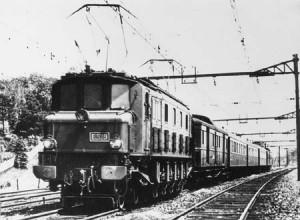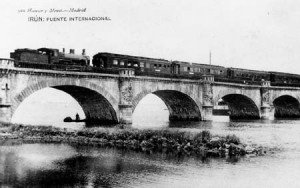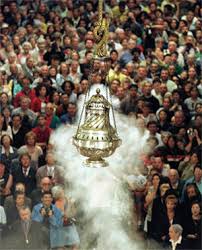It’s one of the strange, true but little-known aspects of the Spanish Civil War that, in July 1938, with the conflict still very much in the balance, the fascist General Franco was so sure of winning that he opened up the territory he had conquered in northern Spain for tours of his battlefields.
For anybody who wants a more academic account of the War Routes, here’s the article written by Professor Sandie Holguín , (University of San Diego, California), “National Spain Invites You”: Battlefield Tourism During the Spanish Civil War.
These tours provide the setting for The Assassin’s Mark and, before doing my final re-write, I decided that Ann and myself would take the same route followed by my fictional characters, but also the route taken, for the most part, by the actual groups of international travellers (a minimum of 6,000 and possibly as many as 20,000) between 1938 and 1945.
Our own tour “cheated” (as does the novel) by having the route extend as far as Santiago de Compostela but, otherwise, it followed precisely the itinerary set out in the English-language version of Franco’s Northern War Route brochure, National Spain Invites You.

Many of the roads taken by the 14-seater Chrysler buses back in 1938 are still there, though significantly improved. And there are also decent local train and bus connections between most of the places mentioned here. In fact, the whole trip can be undertaken using public transport. But we made most of the journey in our modest motorhome, since it seemed more in keeping with the actual tours.
Thursday 10th November 2011
Reflection & Chapters 1-4
So let’s begin where the first of the tours began. At Irún.


Irún stands on the western edge of the border between France and Spain, and the International Bridge links the northern suburb of the town to Hendaye on the French side of the river. This is where Franco met Hitler during the German Chancellor’s first visit in 1940 after the Nazis had done so much to help the Generalísimo win the Spanish Civil War. On the Spanish side, at Irún, you’d change trains if travelling on the Sud Express from Paris to northern Spain or to Lisbon; and here at Irún that Franco’s forces succeeded in cutting off the Republican Army of the North from the rest of the country, early in the conflict.

It’s good to walk the pedestrianised old bridge now, looking back on the town and remembering the place as it appears in so many old photos – a wall of flame, set alight by the Republican defenders in a “scorched earth” attempt to hamper the Nationalist advance. But it’s worth spending time in Irún itself too, to see some of the pre-war buildings that still survive and which feature in The Assassin’s Mark – the Parish Church of La Joncal, the town hall, and the Calle Mayor.

A short drive out of Irún takes us to Hondarribia (formerly Fuenterrabía), where the War Route tourists went to have their passport and customs checks – since Irún was still too badly devastated in 1938 to provide attractive accommodation. So Ann and myself take coffee at the Hotel Jaúregui, where the checks took place, and still going strong. There’s a nice model in the foyer showing the way it looked in 1938! The hotel sits in the “new town”, the northern part, which looks like it’s remained unchanged since the 17th Century. Beautiful multi-coloured houses. Then we head uphill to the “old town”, walled and with a great square housing the local Parador, as well as a couple of charming eating places – though you’ll need to ask what’s on offer, since they don’t seem to bother with niceties like menus.
Friday 11th November
Chapters 5-8
We start at the huge María Cristina Hotel, closed for refurbishment at the time but subsequently open for business once more. There are some disturbing scenes set here in the novel since, once again, this is where the real War Route tourists stayed. It was also the scene of heavy fighting when Franco’s forces advanced here from Irún and the outer walls remain pockmarked with bullet holes. Then we saunter around the Central Market; the old quarter; the Plaza de la Constitución, where bullfights used to be held, with spectators paying to use the numbered windows of the houses lining the square; and the long Calle Jerónimo – with the old Basilica at one end and the new Cathedral in the distance at the other. This is the area entirely destroyed in a firestorm created by the British army when they attacked and sacked the town during the Peninsular War.

On the western edge of the old quarter, you come out onto the harbour area, with its 1930s Aquarium, and the castle above, on the hill of Monte Urgull. A walk around the promenade to the seaward side of Monte Urgull, and up into the gardens there, brings you to the English Cemetery – actually filled with those British soldiers (including my ancestor, Colonel F.C. Ebsworth) who went out to fight as volunteers in one of Spain’s earlier civil wars, this one in 1836, the First Carlist War.

Retracing our steps, and now following the beach westwards on the Playa de la Concha, we buy takeaway pizza and empanada in the new town, and picnic in the Miramar Gardens, below which the Spanish Royal Family’s enormous beach pavilion used to run on rails up and down to the water’s edge, with the ebb and flow of the tide. It may be November, but the sea’s still warm enough (just about) for a brisk swim here, where The Assassin’s Mark has its macabre finale.
And we finish the day wandering the posh shops near the Cathedral.
Saturday 12th November
Chapters 9-11

We drive to Eibar and then follow the N634 to Durango and Amorebieta, each the scene of heavy fighting during the Nationalists’ advance and, in Amorebieta’s case, the site of probably the first experiment in aerial bombardment of civilian targets – by the German Condor Legion, of course. Then we take the N635 to Guernica (Gernika-Lumo) for a visit to the Peace Museum, which tells the tragic tale of the German bombing of the town in 1937, as well as the Casa de Juntas and the famous Tree of Guernica.

In the late afternoon, we take a slight detour to Mungia (Laukariz) to visit the Palacio Urgoiti. This building used to stand many miles away, at Galdakao, and was another stop-over venue for the War Route tours. But when a new road was proposed, the owners had it taken apart, stone by stone, and rebuilt here at Mungia, where it’s now a high quality golfing destination.
In the evening, we end up on a campsite at Sopelana, so that we can more easily travel into Bilbao on the following day.
Sunday 13th November
Chapter 12

We walk to Sopelana metro Station, where an incredibly helpful lady attendant explains the whole system to us and helps us buy the best tickets. It’s 40 minutes to Bilbao city centre (Plaza Moyúa), from where we walk to the Guggenheim, then cross the Nervión River to find Plaza Funicular and ride to the top of Monte Artxanda. There’s a Civil War monument up there and great views of the city. We ride the funicular back down again surrounded by local school-kids – who I later wrote into the story. Walking back toward the old quarter, we pass the Town Hall and try to get inside so that we can see the famous Salon Árabe, but you need to book well in advance to stand any chance of a visit. So we stroll around the bookshops of the old quarter instead, then visit the fabulous San Sebastián-Bilbao Railway Station and the Ensanche district, reminiscent of Paris boulevards, before finishing our tour at the Hotel Carlton – the last headquarters of the Basque Government before the region finally fell to Franco.
Monday 14th November
Chapter 13
We drive around the outskirts of Bilbao to find the A634 again and head for Castro Urdiales, then Laredo – where we stop for lunch and the views across the bay to the headland of Santoña, where the Basque battalions from the Republican Army of the North finally surrendered to the Italians in 1937. The Italians initially agreed that they could be evacuated on British ships in the harbour but, when Franco heard the news, he reversed the decision and had something in the order of 15,000 thrown into concentration camps.
In the afternoon, we arrive in Santander.
Tuesday 15th November
Chapter 13
Santander is one of those cities that folk “pass through” (usually via the Brittany Ferries terminal there) but rarely explore – which is a great shame. There’s plenty to see here: the Playa del Sardinero; the Magdalena Royal Palace, there on the promontory; the passenger ferries to the eastern beaches; the Cabo Mayor park and lighthouse; the Casino building; the Maritime Museum; and the Plaza Porticada. There’s also the classic Hotel Real, which towers over the bay, and another place where the War Route tour groups stayed. There’s the famous Pardo House just next to the hotel too.

Wednesday 16th November
Chapter 14

We arrive in Altamira to visit the caves and their prehistoric paintings, before dropping down into Santillana del Mar for lunch and a look at the Parador (formerly a barracks for the Guardia Civil). No trip along the north coast is complete without a visit to ancient Santillana though, for me, it’s something of a lifeless museum piece, nowhere near as exciting, for example, as Hondarribia. But at least it has a five-star campsite. And it’s also a popular stop-over on the famous Camino de Santiago (the coastal route).
Thursday 17th November
Chapters 15-23
Off to Comillas, then a stop for coffee at San Vicente de la Barquera, before taking the back road (114) and stunning mountain passes through the northern edge of the Picos de Europa. These are the same passes defended by the Republican Army of the North as it fell back before the advancing fascist troops. It was here that they held the mountain of El Mazuco for eighteen days, with little more than rocks and sticks of dynamite (actually Chapter 24 of the book) before they were finally forced westward, to Gijón. But, before that, we turn off on the side road to Covadonga, the spiritual and religious heart of España Profunda. It’s quite an experience with the enormous Basilica suddenly rising up before us in the middle of nowhere as we climb the road leading to the place.
The Basilica, when we get there, is filled with silent supplicants. And so is the Cueva de la Santina, the cave with its statue of the Virgin, now returned to its home here after having been “kidnapped” by the Republicans – and also the cave in which rests the tomb of medieval Spanish hero, Pelayo. And it’s in this same cave, of course, that so much of the action in The Assassin’s Mark takes place. We eat late lunch in Cangas de Onís in a barbecue restaurant, eating fabada asturiana with strong local cider/scrumpy. Wonderful!

Then it’s on to Oviedo which, in 1936, had unexpectedly declared for Franco and the Nationalists. This resulted in the army commander, Aranda, defending the place for three months against almost impossible odds. Remnants of the siege are still very much in evidence around the outskirts.
Friday 18th November
Chapters 24-25
Gijón is the largest city in Asturias but also has fabulous beaches and rich architecture. It was here that the Republican Army of the North finally ran out of road and was forced to surrender, bringing this particular campaign to an end on 21st October 1937. The Republic had lost 200,000 men. But Gijón now boasts a great Botanic Garden, the San Lorenzo beach, a charming outdoor sea-water swimming pool. And, not too far away, is Ribadeo and the Playa de las Catedrales.


Saturday 19th November
Chapters 26-28
Early start this morning for Santiago de Compostela, and cheating a bit – using the AP9 motorway so that we get there in time for the midday Pilgrim’s Mass at the Cathedral. It was seeing the Mass taking place, with that dangerous-looking use of the huge incense burner, the botafumeiro, which inspired me to include the scene within the novel.

And where better to stage the story’s climax than the great square, the Plaza del Obradoiro, flanked on three sidesby the Cathedral, the Parador, and the Palacio Rajoy respectively? We eat a picnic lunch in the Alameda Gardens, walk the Medieval streets, and pay our own small pilgrimage to the Troya House Museum, on Rua da Troia, and location of a famous Spanish novel by Pérez Lugín. And tonight we stay just outside town at the Camping As Cancelas.


Onward Journey
Chapter 29 & Postscript
Anybody who’s reading The Assassin’s Mark as they follow the route will now want to head back sharpish to San Sebastián for the story’s finale. Alternatively, you could make one last journey, to Finisterre, Cabo Fisterra, the most westerly point on the European mainland, and sit on the cliffs to read the final chapter, with just the wild Atlantic for company.
But I had cause to revisit the War Routes while I was writing the third of the Jack Telford novels, A Betrayal of Heroes. This one finds Jack in Lisbon during 1943 and there he’s reunited with one of the fellow-travellers from his earlier adventures.
By now – and factually – Franco had extended the tours. Three new itineraries. Besides the original War Route of the North, similar trips were now available around the battlefields of Andalucía, of Cataluña and, finally, of Madrid.
And yes, this was 1943, with tourists from all over Europe still travelling to “neutral” Spain and take up Franco’s invitation. A one-week holiday. £8.00 for food, accommodation and the bus, with travellers having to make their own transport arrangements to reach the starting point for the respective tours.
From Britain, this involved one of the three scheduled civilian flights each week from Bristol Whitchurch airfield to Lisbon and, from there, by train to Irún, Sevilla, Barcelona or Madrid itself. Extraordinary? Yes, but absolutely true!

Leave a Reply